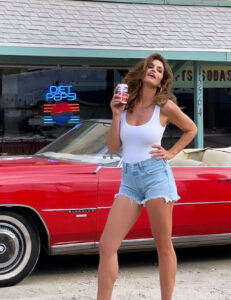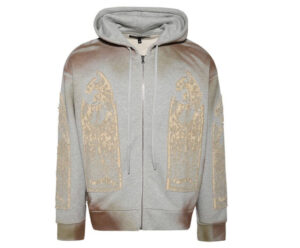In the canon of American advertising, there are moments that don’t just sell products—they sear themselves into public consciousness, reconfiguring cultural hierarchies, visual memory, and commercial logic all at once. Cindy Crawford’s 1992 Pepsi commercial stands at this apex. Not merely an endorsement, nor just a flash of beauty in slow motion, the ad encapsulated a very specific energy—a kind of confident intrigue that managed to do what few soft drink campaigns could: transcend the beverage itself. It offered a distilled shot of aspirational Americana, sexuality reimagined as strength, and a generational mirror reflecting the collective thirst for something cooler than Coke.
This editorial seeks to explore that energy—not only how it offered a surge of revitalizing interest in Pepsi but how it operated differently from other brand endorsements of the time. The 1992 Cindy Crawford ad wasn’t a stunt, nor was it a gimmick. It was a strategic alignment of brand identity, star power, and emotional simplicity in an age of heightened visual literacy. In its mere thirty seconds, it captured a zeitgeist—one that continues to reverberate through fashion, marketing, and soft drink culture today.
The Scene: A Denim Dream at a Desert Gas Station
Set in the sweltering brightness of a remote American gas station, the ad opens with Crawford’s red convertible kicking up dust as she pulls in. Emerging from the vehicle in a white tank top and cutoff denim shorts, Crawford strides confidently to a vending machine. Two young boys watch wide-eyed from behind a wooden fence as she pops the tab on a can of Pepsi and takes a long, satisfying drink.
There are only a few spoken words, and none from Crawford. The commercial relies on body language, cinematographic pacing, and musical cue—the track “Just One Look” by Doris Troy—to structure its arc. The payoff comes in the children’s astonished comment: “Is that a great new Pepsi can, or what?” It’s a humorous deflation, revealing that their awe isn’t for Crawford, but for the sleek new Pepsi can design.
This tongue-in-cheek reversal conjures on the viewer’s expectations, delivering irony wrapped in iconography. It pokes fun at objectification while simultaneously leveraging it. Yet it’s not exploitative. Instead, Crawford’s portrayal is unapologetically self-aware, as if to say: yes, this is a spectacle—and she’s in full control of it.
Soft Drink Symbolism: More Than a Sip
In the early 1990s, the Cola Wars were nearing their cultural peak. Pepsi had long positioned itself as the drink of the “Next Generation,” relying heavily on celebrity endorsements to signify its edge. Michael Jackson, Madonna, and Ray Charles had all taken up the Pepsi banner. Coca-Cola, on the other hand, remained rooted in heritage, tradition, and nostalgic Americana. Pepsi sought something sleeker, more contemporary, even a bit rebellious.
Enter Crawford. A supermodel with substance, she wasn’t just a pretty face—she was a trained chemical engineer turned media mogul, with a burgeoning portfolio of magazine covers and fitness videos. Her alignment with Pepsi was both aesthetic and aspirational. Where Coke had polar bears and Norman Rockwell sentimentality, Pepsi now had a living embodiment of ’90s power beauty.
That “energy” wasn’t about raw sex appeal; it was about polish, confidence, and an unapologetic stance. Crawford didn’t stumble into frame or flirt with the camera in coquettish fashion. She moved with purpose. She drank the Pepsi as if claiming it for herself, not selling it to anyone else. That subtle difference in posture—agency rather than performance—imbued the commercial with an edge other endorsements lacked.
Comparative Energies: The Pepsi vs. Cola Divide
To understand the full impact of the Crawford ad, one must examine it alongside contemporaneous campaigns. Coca-Cola, still reveling in its conservative ethos, ran campaigns that emphasized family moments, holiday themes, and “real moments” of refreshment. These were effective in their own right, particularly across middle America and among older demographics, but they lacked the kinetic pulse that Pepsi cultivated with its celebrity-fronted campaigns.
Pepsi’s approach, especially in 1992, was one of modernity. The brand wasn’t just selling a drink—it was marketing lifestyle, texture, and momentum. Its commercials moved faster, sounded louder, and glowed brighter. In an era that was beginning to worship velocity and visibility—MTV cuts, neon lighting, and the dawning internet age—Pepsi’s aesthetic pivot aligned perfectly with Crawford’s star wattage.
Compare this to other female-led endorsements of the era. There was a marked difference in tone and style. Think of the highly choreographed, often reductive presentation of women in fragrance ads, for example. Or the polished, pristine beauty of cosmetic campaigns that flattened individuality in favor of idealized perfection. Crawford’s Pepsi spot upended those models by making imperfection—the tousled hair, the dirt road, the can gulp—a source of charisma. She wasn’t airbrushed into alien glamour; she was earthy, legible, and real. That realism, though cinematic, created emotional accessibility.
In doing so, Pepsi didn’t just gain a brand ambassador—it carved out a visual manifesto.
Temporal Resonance: What 1992 Needed
The early 1990s were a transitional moment in American pop culture. The Cold War had ended. MTV was reprogramming adolescence. The internet was a whisper. Hip-hop had broken into the mainstream, and grunge was rising in Seattle. There was a sense that the old order was dissolving, and something electric—if undefined—was about to take its place.
Crawford’s commercial didn’t claim to define that cultural pivot, but it instinctively understood it. Her look channeled Americana, but with postmodern self-awareness. She was the cowboy and the cowgirl, the hero and the object of admiration. The ad’s setting, a dusty roadside pit stop, felt like the frontier. It offered a romantic vision of the open road that was less about nostalgia and more about possibility.
And then there was the drink itself: Pepsi. Canned cool. A totem of freshness and fizz. In an age increasingly defined by image and attitude, Pepsi’s association with that confident stride and knowing smirk gave it emotional velocity. It wasn’t just a soda anymore. It was a shortcut to charisma.
Enduring Legacy and Replication
Even decades later, the Crawford-Pepsi ad continues to be revisited, remixed, and referenced. In 2018, Crawford recreated the ad for Pepsi’s Super Bowl spot, standing in the same tank top and denim, this time joined by her son Presley Gerber. The message wasn’t just nostalgia—it was about generational continuity. Confidence, simplicity, and charisma age well.
What made the original commercial so magnetic—and why it remains iconic—was that it didn’t feel like marketing. It felt like a music video, a silent short film, a cultural wink. It respected the intelligence of its audience. It trusted the power of minimalism. And most importantly, it understood that style is not just what you wear—it’s how you move, how you look when you think no one is watching.
As advertising has grown increasingly complex—fueled by data analytics, viral trends, and algorithmic targeting—it’s worth revisiting the elegant bluntness of Crawford’s Pepsi moment. No hashtags. No TikTok dances. Just a woman, a can, and an indelible scene that still lingers like carbonation on the tongue.
Energy as Emotional Architecture
So what was this “energy” that Crawford and Pepsi conjured in 1992? It was a kind of effortless allure, a kinetic quiet that spoke louder than any catchphrase. It was the rare advertisement that didn’t insist or manipulate—it invited. In a time when soft drink companies vied for dominance through flashy effects and volume, this ad offered a serene force, grounded in human magnetism rather than technological bravado.
Cindy Crawford’s Pepsi commercial remains more than a relic; it is a blueprint for understanding how brand storytelling can move beyond product and into poetry. It is the rare example where a commercial not only sold cans—but bottled time, desire, and aspiration.
No comments yet.









